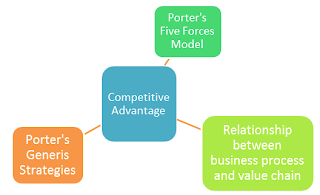Chapter 2 (Identifying Competitive Advantage)
Chapter 2 – Identifying Competitive Advantage
Introduction
What is competitive advantage?
- - A product or services that an organization’s customers place a greater value on than similar offerings from a competitor
- - Unfortunately, CA is temporary because competitors keep duplicate the strategy.
- - Then, the company should start the new competitive advantage
Michael Porter’s Five Forces Model is useful tool to aid organization in challenging decision whether to join a new industry or industry segment
1. Buyer Power
· High – when buyers have many choices of whom to buy
· Low – when their choices are few
· To reduce buyer power (and create competitive advantage), an organization must make it more attractive to buy from the company not from the competitors
· Best practices of IT based
- Loyalty program in travel industry, for example rewards on free airline tickets or hotel stays
The Competitive Environment
Bargaining Power of Customers/Buyer Power
- Customers can grow large and powerful as a result of their market share
- Many choices of whom to buy from
- Low when comes to limited items
- Example, used loyalty programs (Jusco card, Tesco card, being a members to get the discount)
2. Supplier Power
· High – when buyers have few choices of whom to buy from
· Low – when their choices are many
- Best practices of IT to create competitive advantage
- Example, B2B marketplace – private exchange allow a single buyer to posts it needs and then open the bidding to any supplier who would care to bid. Reverse auction is an auction format in which increasingly lower bids
An organization within the Supply Chain
- - Supplier power is the converse of buyer power
1. Threat of Substitute products and services
· High – when there are many alternatives to a product or service
· Low – when there are few alternatives from which to choose
· Ideally, an organization would like to be on a market in which there are few substitutes of their product or services
- Best practices of IT
- Example, Electronic product – same functions different brands
The Competitive Environment
Threat of Substitutes
- - To the extent that customers can use different products to fulfill the same need, the threat of substitutes exists
- - Example, electrical product – same function different brands
- - Switching cost – costs can make customer reluctant to switch to another product or service
2. Threat of new entrants
· High – when it is easy for new competitors to enter a market
· Low – when there are significant entry barriers to entering a market
· Entry barriers is a product or service feature that customers have come to except from organizations and must be offered by entering organization to complete and survive
· Best practices of IT
- Example, new bank must offers online paying bills, acc. monitoring to compete
The Competitive Environment
Threat of New Entrants
- - Many threats come from companies that do not yet exist or have a presence in a given industry or market
- - The threat of new entrants forces top management to monitor the trends, especially in technology, that might give rise to new competitors
- - Example, new bank (online paying bills, acc. monitoring)
3. Rivalry among existence competitors
· High – when competition is fierce in a market
· Low – when competition is more complacent
· Best practices of IT
- Wal-Mart and its suppliers using IT – enabled system for communication and track product at aisles by effective tagging system
- Reduce cost by using effective supply chain
The Competitive Environment
Rivalry Among Existing Firms
- - Existing competitors are not much of the threat: typically each firm has found its “niche”.
- - However, changes in management, ownership, or “the rules of the game” can give rise to serious threats to long term survival from existing firms
- - Example, the airline industry faces serious threats from airlines operating in bankruptcy, who do not the debts while slashing fares against those healthy airlines who do pay on debt. (MAS & AIR ASIA)
The Value Chains – Targeting Business Processes
- Supply Chain – a chain or series of processes that adds value to product and service for customer
- Add value to its products and services that support a profit margin for the firm








Comments
Post a Comment